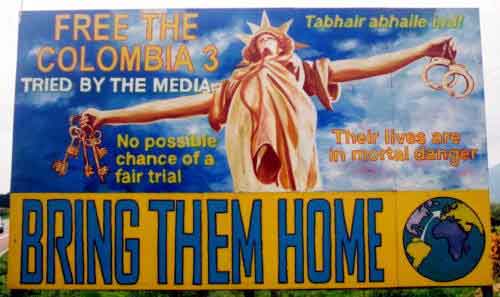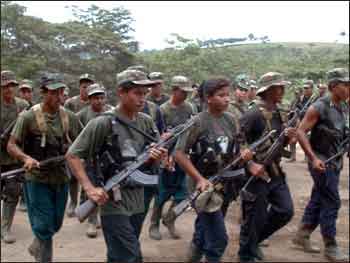|
When the
songwriter Renaud launched 'Dans la jungle' in December 2005
to support Ingrid Betancourt and other hostages abducted in
Colombia, some were surprised to hear in the lyrics certain
echoes of the war on terror currently being waged by the
United States and other governments. Betancourt, a Colombian
politician who adopted French citizenship and founded the
Oxígeno Verde green party, was kidnapped on 23 February 2003
by the Revolutionary Armed Forces of Colombia (FARC). The song
itself is a continuation of Renaud's long career as a writer
of protest songs. He highlighted the double standards of
Colombian guerrillas who claimed to wish to improve society
and yet became a criminal army. However one could perceive in
the French songwriter's most recent work a common worldview in
which Latin America is depicted as a 'jungle', or a place
steeped in corruption, chaos and turmoil, in contrast to the
supposed honesty and civilisation of life and politics in
Europe.
The Irish
Republican Army's (IRA) alleged connections with FARC surfaced
in 2001 and continue to appear in the Irish and Colombian
media. I consider the ongoing affair an ideal opportunity to
analyse perceptions of Latin America in Ireland. For the
purposes of this article I used the limited number of relevant
documents available to the public, together with online
newspaper articles and interviews conducted by email. Rather
than unveiling new information or undertaking a definitive
account, the object of this article is to examine opinions
that reveal values and beliefs regarding Latin America and its
cultures.
Gangs of Colombia
Among
Colombian rebel groups, according to the US Department of
State, FARC 'is the oldest, largest, most capable, and
best-equipped insurgency of Marxist origin' (US Navy NPS
2005). 'Foreign citizens are often targets of FARC kidnapping
for ransom. The FARC has well-documented ties to the full
range of narcotics trafficking activities, including taxation,
cultivation, and distribution.' It comprises 'approximately
9,000 to 12,000 armed combatants and several thousand more
supporters, mostly in rural areas' (US Navy NPS 2005). Several
of the recruits are under eighteen years old and a third are
women.
FARC has
proclaimed itself a political-military Marxist-Leninist
organisation inspired by Bolivarian ideals.
[1] It claims to
represent the rural poor in opposition to
Colombia's
wealthy classes, and opposes US influence in the region and
neo-liberal policies. FARC was created on 27 May 1964 during
Operation Marquetalia, when the Colombian Army overran this
enclave held by peasant guerrillas, with key leaders such as
Manuel Marulanda Vélez and Jacobo Arenas. The first conference
was organised in 1965 and was attended by 100 guerrillas.
Internal feuds resulted in a lack of unified strategies until
1974, when a metamorphosis was implemented from a guerrilla
force into a revolutionary army. After the sixth conference in
1978, FARC operated in the Guayabero area. In 1982 the
official name was changed to Revolutionary Armed Forces of
Colombia - People's Army (FARC-EP), and the political-military
Bolivarian Campaign was launched. A cease fire was negotiated
with the Colombian government in late 1984, and FARC supported
the parliamentarian candidates of the Patriotic Union party.
Murders by the regular armed forces and paramilitary groups
provoked a violation of the armistice and FARC resumed
fighting in 1987. A new peace process began in 1991 but lasted
only until 1992. Intensive military campaigns led by FARC
resulted in another round of negotiations with the government.
In the hope of negotiating a peace settlement, on 7 November
1998 president Andrés Pastrana granted FARC a 42,000 sq. km
safe haven at San Vicente del Caguán in Caquetá department.
This was the condition which FARC dictated for the initiation
of peace talks. The peace process came to a halt in February
2002 after a series of high-profile actions, among them the
kidnapping of political figures. FARC's international
connections include links with Cuba and with radical groups in
Latin America, most notably in Peru and more recently in
Paraguay.
One of the
paramilitary groups combating FARC, the United Self-Defence
Forces of Colombia (AUC) is portrayed as an armed organisation
that protects local economic, social and political interests
by fighting Marxist insurgents, citing the excuse that the
Colombian government has historically failed to do so. Its
forces are estimated at between 10,000 and 20,000 militants,
and it is considered to be a terrorist organisation by most
countries, including the US. In 2000, former AUC leader Carlos
Castaño Gil claimed that 70 per cent of the AUC's operation
costs were financed through drug-related activities. Both FARC
and AUC are accused of being key players in contraband drug
production and distribution, and are therefore targets of the
internationally-sponsored Plan Colombia.
With
the primary aims of bolstering Colombia's social and economic
development, combating the drug production and trade,
strengthening government institutions, and ending armed
conflict with insurgent groups, Plan Colombia was launched by
the administration of president Andrés Pastrana in October
1999. Over one third of the original budget of US$7.5 billion
was pledged by the international community. The Clinton
administration in the US donated US$1.3 billion, and assigned
military personnel to train local forces, and experts to
assist in the eradication of coca plantations. These
contributions to the plan made Colombia the third largest
recipient of foreign aid from the US at that time. Further
funding from the Bush administration was approved under the
provisions of the Andean Counterdrug Initiative. Support from
the European Union and some countries outside the EU met with
little co-operation amid severe criticism, in particular of
the procedure of aerial fumigation to eradicate coca. This
activity allegedly damages legal crops and has adverse effects
on the health of those exposed to the herbicides. Critics of
the initiative also claim that elements within the Colombian
security forces who receive aid and training from the Plan may
be involved in supporting the AUC paramilitary forces.
Moreover, recent research has shown that Colombia's economic
problems are more related to political violence than to the
drug trade in itself. [2]
|




